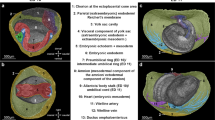Abstract
To clarify the embryological etiology of various malformations, we recently developed a computerized three-dimensional (3D) reconstruction system for analytical observation of real structures in a small fetus and applied this technique for the analysis of anorectal embryology. Fifty-one pig fetuses were obtained from two porcine families with anorectal malformations established in our facilities. They were sectioned sagitally and 3D structures of the anorectum were reconstructed from serial sections and analyzed. In the young pig embryo (24–30 days), the cloaca exists as a cloacal plate, a very thin, flat structure vertical to the body surface. It is filled with basophilic cells and contains no cavity. Therefore, the body surface covering the urogenital and rectal area may not be recognized as a single membranous structure. In the reconstructed image of the cloacal plate, the proximal part, which lies between the hindgut and tail groove, was defective in the specimens with anorectal anomalies whereas the cloacal plate existed from the entire anterior part to the posterior ene of the tail groove in the normal specimens. This result supports the theory of van der Putte that anorectal malformations are caused by a defect of the cloacal plate between the hindgut and tail groove.
Similar content being viewed by others
References
Bill AH, Johnson RJ (1958) Failure of migration of the rectal opening as the cause for most cases of imperforate anus. Surg Gynecol Obstet 106: 643–651
Gray SW, Skandalakis JE (1972) Embryology for surgeons. WB Saunders, Philadelphia, pp 202–211
Kluth D, Steding G, Seidl W (1987) The embryology of foregut malformations. J Pediatr Surg 22: 389–393
Lambrecht W, Kluth D, Liese W (1989) Epithel und Proktodealdrüsen in Rektumblindsacken und Fisteln. Z Kinderchir 44: 41–46
Ohkawa H, Sawaguchi S, Kaneko M, et al (1984) Basic studies on the anorectal malformations. II. Considerations on the significance of swine imperforate anus as a therapeutic model. J Jpn Soc Pediatr Surg 20: 11–17
Ohkawa H, Sawaguchi S, Kaneko M, et al (1986) Basic studies on the anorectal malformations. III. Studies on the heredity of swine anorectal anomalies. J Jpn Soc Pediatr Surg 22: 511–518
Stephens FD (1963) Congenital malformations of the rectum, anus and genitourinary tracts. London, Livingstone, pp 118–131
Van der Putte SCJ, Neeteson FA (1983) The normal development of the anorectum in the pig. Acta Morphol Neerl Scand 21: 107–132
Van der Putte SCJ, Neeteson FA (1984) The pathogenesis of hereditary congenital malformations of the anorectum in the pig. Acta Morphol Neerl Scand 22: 17–40
Van der Putte SCJ (1986) Normal and abnormal development of the anorectum. J Pediatr Surg 21: 434–440
Author information
Authors and Affiliations
Additional information
Correspondence to: H. Ohkawa
Rights and permissions
About this article
Cite this article
Ikebukuro, Ki., Ohkawa, H. Three-dimensional analysis of anorectal embryology. Pediatr Surg Int 9, 2–7 (1994). https://doi.org/10.1007/BF00176096
Accepted:
Issue Date:
DOI: https://doi.org/10.1007/BF00176096




